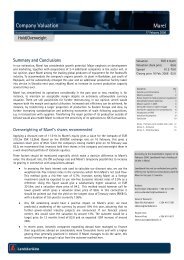Ársskýrsla Landsbankans - Landsbankinn
Ársskýrsla Landsbankans - Landsbankinn
Ársskýrsla Landsbankans - Landsbankinn
Create successful ePaper yourself
Turn your PDF publications into a flip-book with our unique Google optimized e-Paper software.
Notes to the Consolidated Financial Statements<br />
49. Effects of the financial crisis (continued)<br />
Situations may differ between individuals and this calls for varying solutions, customised to fit the needs of each customer. Solutions are based on<br />
an overall assessment of each customer’s financial situation. The Group provides several remedies for individuals experiencing financial difficulties<br />
based on legislation or developed internally by the Group. The remedies variously consist of general measures and/or involve more extensive actions.<br />
The Group has approved a framework to govern the financial restructuring of companies that have a business relation with the Group and are<br />
experiencing financial difficulties. The framework is intended to elaborate on the government’s declaration, Act No. 107/2009 (on actions for the<br />
benefit of individuals, households and companies due to the collapse of the banks and currrency) and Joint Rules on the Financial Restructuring of<br />
Companies agreed upon by the members of the Icelandic Financial Services Association.<br />
Credit risk<br />
50. Credit risk<br />
Credit risk is defined as the risk that a party to a financial instrument will cause a financial loss for the Group by failing to discharge its obligations.<br />
Due to the effects of the financial crisis, there is rather high uncertainty concerning the recovery of the loan portfolio. This uncertainty is reflected<br />
by traditional measures of credit risk.<br />
Credit risk is the greatest single risk faced by the Group and arises principally from loans and advances to customers and from investments in debt<br />
securities. However, it also arises from issued guarantees and letters of credit which commit the Group to pay a third party in the event of customer<br />
inability to fulfil obligations. Guarantees and documentary credits are secured by the goods shipments they cover, thus representing a lower risk than<br />
direct loans. Unused credit lines represent commitments to increase loans or guarantees. Conceivably, the Group could suffer losses equivalent to the<br />
total of open credit lines. Credit risk also arises from derivative contracts where the Group can incur financial losses if the amount to be settled is<br />
positive for the Group, after netting and realisation of collateral.<br />
51. Credit risk management<br />
The Group manages credit risk by setting limits on acceptable exposures to individual borrowers or groups of related borrowers. Such limits are<br />
monitored and regularly reviewed. Credit risk is also managed by modifying authorised credit limits or acquiring preferable collateral for existing<br />
client obligations.<br />
The Group's p management g and control of credit risk is centralised. The Board of Directors sets the Groupp lendingg policy, p y with the purpose p p of<br />
controlling overall Group exposure by the combined, comprehensive monitoring of indirect risk exposure through clients and direct claims of the<br />
Bank and its subsidiaries.<br />
Credit risk is managed by the Risk and Finance Committee, the Credit Committee and its sub-committees. The Risk Management Division manages,<br />
monitors and measures credit risk and reports on credit risk quarterly to the managing directors and the Board of Directors. The lending policy<br />
approved by the Board of Directors and the Risk and Finance Committee indicates the maximum allowable exposure to individual borrowers and<br />
groups of related borrowers.<br />
The CEO sets detailed lending rules based on the policy approved by the Board of Directors. Lending authorisation levels are well-defined and<br />
incremental. Lending authorisations within the branch network vary according to branch size and the lending experience of credit officers, with<br />
higher lending authorisations being granted to branch managers and corporate relationship managers. The highest lending authorisation in the Group<br />
is in the hands of its Corporate Banking Division. Loans exceeding authorisations set by the lending rules require approval by the Credit Committee,<br />
which may approve loans falling outside the authorisations stipulated in Group lending rules. The Credit Committee delegates and reviews employee<br />
authorisation levels and is responsible for reviewing lending rules. Comprised of the Bank’s CEO and the managing directors of Corporate Banking<br />
and Financial Operations, the Credit Committee meets regularly to discuss all credit decisions which exceed the authorisation levels of branches and<br />
the Corporate Banking Division.<br />
Changes to the composition of the Credit Committee have been proposed and will be implemented in 2011. New lending rules have been approved<br />
by the Board of Directors and are in the process of being implemented. These changes aim to involve Risk Management Division to a larger extent<br />
than before in the lending process as well as setting credit approval limits on business units and credit committees. These changes will emphasis<br />
roles and responsibilities of all departments involved in the process.<br />
NBI hf. Consolidated Financial Statements 2010 53<br />
All amounts are in ISK million<br />
Allar upphæðir eru í milljónum króna Ársreikningur 2010 153



